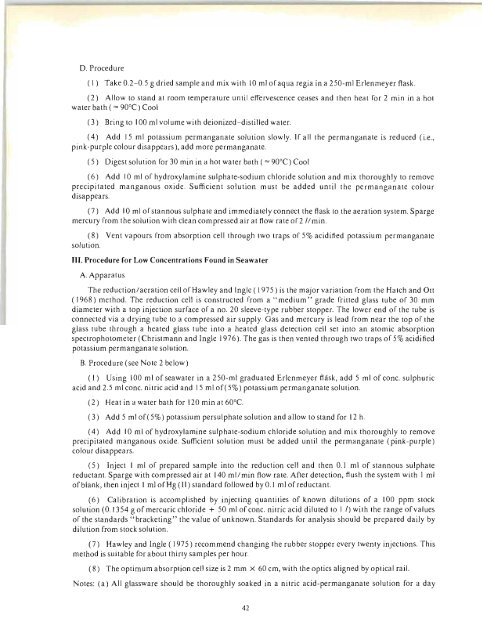You also want an ePaper? Increase the reach of your titles
YUMPU automatically turns print PDFs into web optimized ePapers that Google loves.
D. Procedure<br />
(I) Take 0.2-0.5 g dried sample and mix with 10 ml of aqua regia in a 250-ml Erlenmeyer flask.<br />
(2) Allow to stand at room temperature until effervescence ceases and then heat for 2 min in a hot<br />
water bath ( "'" 90°C) Cool<br />
(3) Bring to 100 ml volume with deionized-distilled water.<br />
(4) Add 15 ml potassium permanganate solution slowly. If all the permanganate is reduced (i.e.,<br />
pink-purple colour disappears), add more permanganate.<br />
(5) Digest solution for 30 min in a hot wa ter bath ( "'" 90°C) Cool<br />
(6) Add 10 ml of hydroxylamine sulphate-sodium chloride solution and mix thoroughly to remove<br />
precipitated manganous oxide. Sufficient solution must be added until the permanganate colour<br />
disappears.<br />
(7) Add 10 ml of stannous sulphate and immediately connect the flask to the aeration system. Sparge<br />
mercury from the solution with clean compressed air at flow rate of2l!min.<br />
(8) Vent vapours from absorption cell through two traps of 5% acidified potassium permanganate<br />
solution.<br />
HI. Procedure for Low Concentrations Found in Seawater<br />
A. Apparatus<br />
The reduction/aeration cell of Hawley and Ingle ( 1975) is the major variation from the Hatch and Ott<br />
( 1968) method. The reduction cell is constructed from a "medium" grade fritted glass tube of 30 mm<br />
diameter with a top injection surface of a no. 20 sleeve-type rubber stopper. The lower end of the tube is<br />
connected via a drying tube to a compressed air supply. Gas and mercury is lead from near the top of the<br />
glass tube through a heated glass tube into a heated glass detection cell set into an atomic absorption<br />
spectrophotometer (Christmann and Ingle 1976). The gas is then vented through two traps of 5% acidified<br />
potassium permanganate solution.<br />
B. Procedure (see Note 2 below)<br />
(I) Using \00 ml of seawater in a 250-ml graduated Erlenmeyer flask , add 5 ml of conc. sulphuric<br />
acid and 2.5 ml conc. nitric acid and 15 ml of( 5%) potassium permanganate solution.<br />
(2) Heatinawaterbathfor 120minat60°C.<br />
(3) Add 5 ml of( 5%) potassium persulphate solution and allow to stand for 12 h.<br />
(4) Add 10 ml of hydroxylamine sulphate-sodium chloride solution and mix thoroughly to remove<br />
precipitated manganous oxide. Sufficient solution must be added until the permanganate (pink-purple)<br />
colour disappears.<br />
(5) Inject I ml of prepared sample into the reduction cell and then 0.1 ml of stannous sulphate<br />
reductant. Sparge with compressed air at 140 ml/min flow rate. After detection, flush the system with I ml<br />
of blank, then inject I ml ofHg (II) standard followed by 0.1 ml of reductant.<br />
(6) Calibration is accomplished by injecting quantities of known dilutions of a 100 ppm stock<br />
solution (0. 1354 g of mercuric chloride + 50 ml of conc. nitric acid diluted to I /) with the range of values<br />
of the standards" bracketing" the vafue of unknown. Standards for analysis should be prepared daily by<br />
dilution from stock solution.<br />
(7) Hawley and Ingle ( 1975) recommend changing the rubber stopper every twenty injections. This<br />
method is suitable for about thirty <strong>samples</strong> per hour.<br />
(8) The optimum absorption cell size is 2 mm X 60 cm, with the optics aligned by optical rail.<br />
Notes: (a) All glassware should be thoroughly soaked in a nitric acid-permanganate solution for a day<br />
42

















